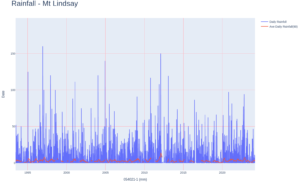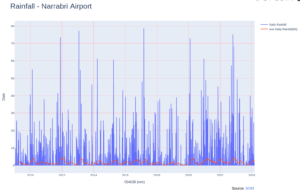The pressure is on groundwater in the Maules Creek valley.
This video shows dramatic scenes of groundwater pouring into the Maules Creek Coal Mine. It is being pumped into a large new dam that could potentially hold over 1 GL of water. Its a “new” dam because it was never envisaged during the original approval. In fact, in the original planning approval, mine production was based on 3 GL of river water licenses provided by Keepit and Split Rock Dams.
Post approval, the groundwater extraction was licensed up to 1100 ML in two tranches of 300 ML and 800 ML by the previous LNP government. The extraction of that groundwater was sanctioned by the planning system when the mine produced confidential groundwater models that fed into it’s Water “Management” Plan. In combination, the models and plans are tick a box exercises designed to justify expanded groundwater take and future mining expansions.
Incredibly, the predictive groundwater models on which the Water Management Plans are based, are regularly delayed and questioned, or totally discredited. For example a Dept of Water 2018 review of the regional groundwater model said;
“Quality of predictions is found to vary from generally reasonable to poor (e.g. observed decline in groundwater level but model predicted rise). No in-depth analysis is provided for noticed correlation or deviation from observations or previous modelled predictions.”
Water Management Plans are part of an “adaptive management strategy” which makes operational changes when observed data varies from the baseline beyond a trigger level. These Plans should be based on accurate, well interpreted groundwater models. But the strategy is inherently unfair when the underlying models and associated monitoring is non transparent or fails; and there is no process for the community to modify the groundwater management or strategy to protect precious reserves. This is such a case.
 In 2024, despite the rainfall data showing a good uptick in district rainfall over summer with plentiful grass across the valley, the early warning signs are there.
In 2024, despite the rainfall data showing a good uptick in district rainfall over summer with plentiful grass across the valley, the early warning signs are there.
Declining groundwater showing up as empty wells and stinking groundwater in the Horsearm Creek / Middle Creek area, are way out of character for these days.The video above is similar to this earlier one from 2019-2020 when aquifer de-watering, pit pumps brought water declines to unprecedented levels earlier and faster than what locals would normally expect.
 We are seeing a repeat of early 2018, (i.e. prior to the 2019 – 2021 drought), when residents experienced dramatic groundwater loss that was very different to previous seasons when in the early stages of drought events.
We are seeing a repeat of early 2018, (i.e. prior to the 2019 – 2021 drought), when residents experienced dramatic groundwater loss that was very different to previous seasons when in the early stages of drought events.
This new video has serious implications for the coming seasons and indicate the next drought event will be far, far worse for groundwater, the community and the environment.
Mar 9 2024
Groundwater pressures in 2024
The pressure is on groundwater in the Maules Creek valley.
This video shows dramatic scenes of groundwater pouring into the Maules Creek Coal Mine. It is being pumped into a large new dam that could potentially hold over 1 GL of water. Its a “new” dam because it was never envisaged during the original approval. In fact, in the original planning approval, mine production was based on 3 GL of river water licenses provided by Keepit and Split Rock Dams.
Post approval, the groundwater extraction was licensed up to 1100 ML in two tranches of 300 ML and 800 ML by the previous LNP government. The extraction of that groundwater was sanctioned by the planning system when the mine produced confidential groundwater models that fed into it’s Water “Management” Plan. In combination, the models and plans are tick a box exercises designed to justify expanded groundwater take and future mining expansions.
Incredibly, the predictive groundwater models on which the Water Management Plans are based, are regularly delayed and questioned, or totally discredited. For example a Dept of Water 2018 review of the regional groundwater model said;
“Quality of predictions is found to vary from generally reasonable to poor (e.g. observed decline in groundwater level but model predicted rise). No in-depth analysis is provided for noticed correlation or deviation from observations or previous modelled predictions.”
Water Management Plans are part of an “adaptive management strategy” which makes operational changes when observed data varies from the baseline beyond a trigger level. These Plans should be based on accurate, well interpreted groundwater models. But the strategy is inherently unfair when the underlying models and associated monitoring is non transparent or fails; and there is no process for the community to modify the groundwater management or strategy to protect precious reserves. This is such a case.
Declining groundwater showing up as empty wells and stinking groundwater in the Horsearm Creek / Middle Creek area, are way out of character for these days.The video above is similar to this earlier one from 2019-2020 when aquifer de-watering, pit pumps brought water declines to unprecedented levels earlier and faster than what locals would normally expect.
This new video has serious implications for the coming seasons and indicate the next drought event will be far, far worse for groundwater, the community and the environment.
By MCCC • Uncategorized •